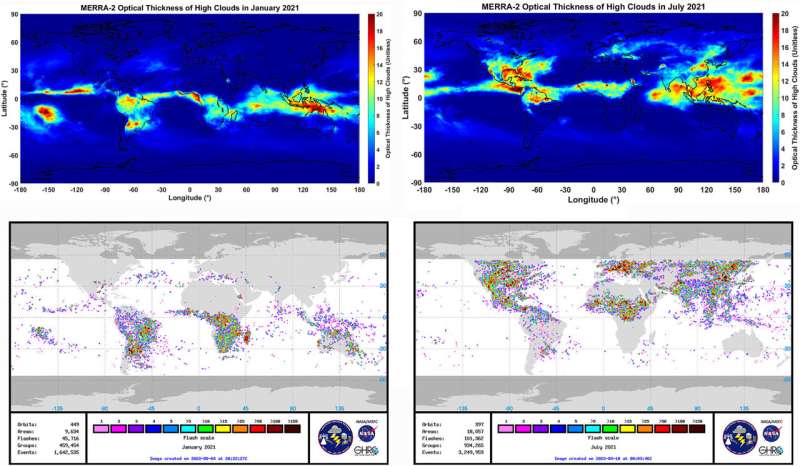This article has been reviewed according to Science X's editorial process and policies. Editors have highlighted the following attributes while ensuring the content's credibility:
fact-checked
peer-reviewed publication
trusted source
proofread
Rise in global thunderstorm activity might increase the quantity of wispy cirrus clouds—accelerating global warming

A new study has found a significant statistical correlation between thunderstorms occurring around the world and the formation of wispy cirrus clouds—which might increase global warming. The researchers say, "We know that cirrus clouds can contribute to global warming. However, it is very difficult to track these clouds and obtain accurate data about them. Our findings indicate that a rise in the number of thunderstorms occurring globally might significantly increase the quantity of cirrus clouds, thereby exacerbating the climate crisis."
The study was led by Prof. Colin Price from the Department of Geophysics at the Porter School of the Environment and Earth Sciences at Tel Aviv University, in collaboration with Dr. Anirban Guha and Joydeb Saha from Tripura University in India. The paper was published in Geophysical Research Letters.
Prof. Price explains, "Cirrus clouds, those feathery clouds we see in the sky, significantly impact the earth's climate. An increase of these clouds will act as a blanket that increases warming, while a decrease will allow the heat of the Earth to rise and escape from the atmosphere. This is why climate researchers are highly interested in cirrus clouds, trying to predict potential changes due to the rise in greenhouse gases and global warming."
"But here we encounter a significant problem: it is very hard to obtain accurate, comprehensive data about cirrus clouds. Being so wispy, they can be invisible to the human eye and even to satellites, plus they form in the upper atmosphere, far from the monitoring stations operating on the ground."
To address this challenge the researchers explored the possibility of predicting the quantity of cirrus clouds on the basis of readily available data about thunderstorms and lightning activity. They explain that the brilliant flash of lightning is formed when a huge electric field is discharged instantaneously, generating a very high temperature of up to 30,000 degrees Centigrade in the lightning channel.
The light waves and radio waves emitted by the lightning discharge can be detected even thousands of kilometers away, enabling long-term monitoring and mapping of thunderstorms.
The present study is based on thunderstorm data collected worldwide over a period of 6 years by the NASA satellite ISS-LIS that detects the light emitted by lightning. The researchers compared these data with data on cirrus clouds (the partial information available combined with supplementary models), looking for a correlation between lightning activity on a specific day, month, or year, and the amount of cirrus clouds formed in the upper atmosphere.
Findings indicate a statistically significant correlation, with the quantity of cirrus clouds increasing with the number of thunderstorms. According to the researchers, this means that thunderstorms, which are easy to detect and measure, can in fact be used as a reliable indicator for the amount of cirrus clouds in the atmosphere, today and in the future.
Prof. Price says, "We discovered that thunderstorms are a major mechanism in the formation of cirrus clouds, and that lightning activity can account for over 70% of the changes in the quantity of cirrus clouds in the world. Thunderstorms act as an enormous "vacuum cleaner," lifting moisture from the surface of the planet, especially above oceans and forests, to higher levels of the atmosphere. There, at an altitude of about 10km, this moisture turns into ice crystals that form the cirrus clouds."
Prof. Price concludes, "In our study we found a significant statistical correlation between the number of thunderstorms occurring across the globe at any given time and the quantity of cirrus clouds formed in the atmosphere. Many models predict that climate change will probably lead to an increase in thunderstorm activity in coming years.""
According to our study, if these predictions are correct, the rise in the number of thunderstorms can be expected to cause an increase in the quantity of cirrus clouds as well. These clouds, in turn, acting as a kind of 'atmospheric blanket," will further exacerbate global warming."
More information: J. Saha et al, The Role of Global Thunderstorm Activity in Modulating Global Cirrus Clouds, Geophysical Research Letters (2023). DOI: 10.1029/2022GL102667
Journal information: Geophysical Research Letters
Provided by Tel-Aviv University





















